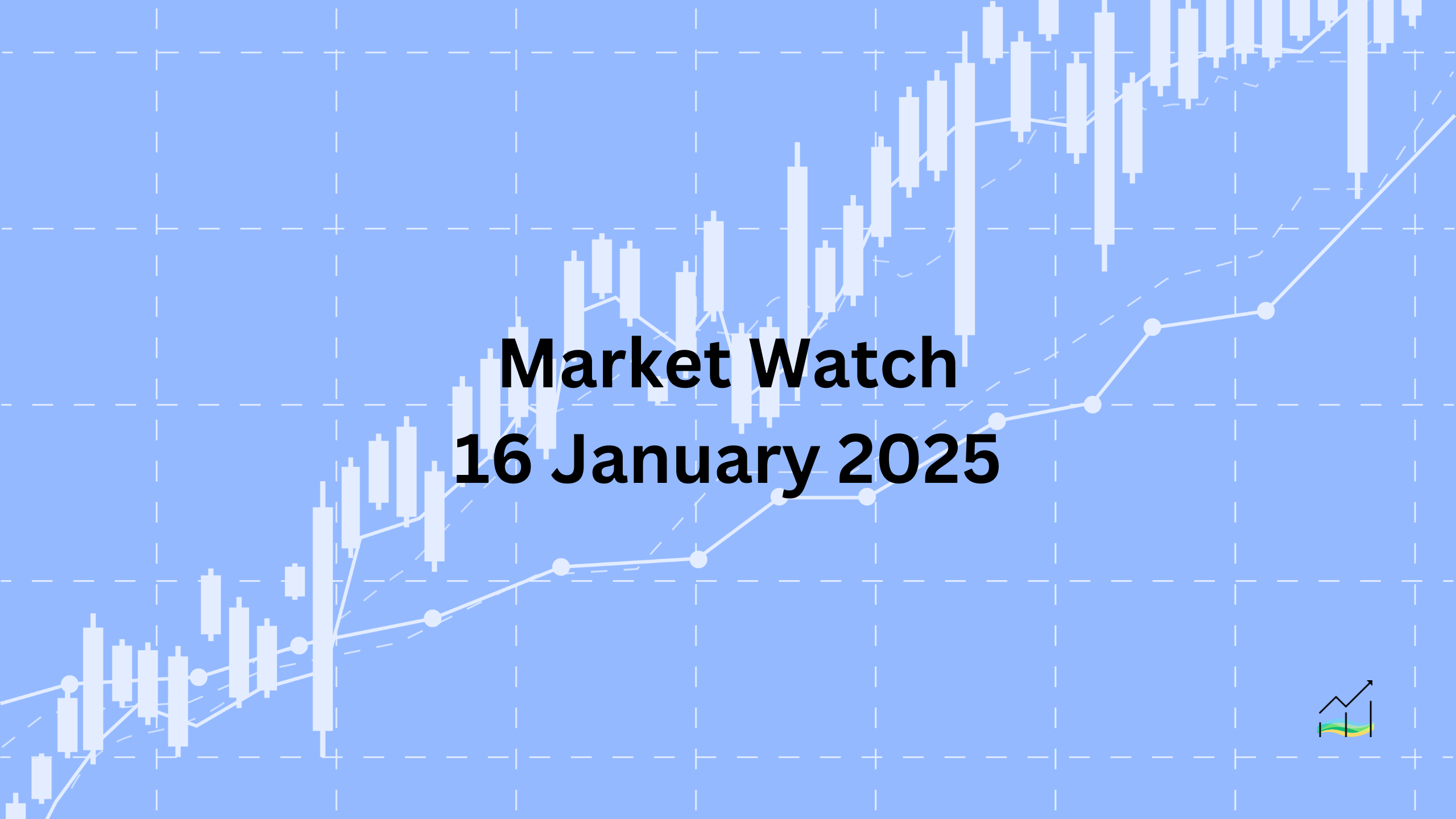16/01/2025 Market Watch

Market Focus Shifts to Real Sector Data
With the release of both US inflation gauges, market focus now turns to real sector data over the next couple of days, alongside the confirmation hearing for the Treasury Secretary nomination today. The dollar's performance is mixed, while the euro, Swiss franc, and Japanese yen are firm. The British pound faces pressure due to disappointing UK GDP figures for November. In Australia, a decline in full-time employment has slightly weakened the Australian dollar, which, along with other dollar bloc currencies, is down around a quarter of a cent. Emerging market currencies are also seeing mixed results.
Equities are largely on the rise today, with indices like the Hang Seng, Taiex, Kospi, and ASX200 climbing over 1%. Europe's Stoxx 600 is continuing its upward trend, adding 0.75% on top of yesterday's gains, while the Dax hits new record highs. US index futures are also trading higher.
In the bond market, 10-year yields in the Asia Pacific region have fallen, reflecting the sharp decline in the US. In contrast, European yields have stabilized and are slightly higher, with the exception of the 10-year Gilt, which has dropped by three basis points. The 10-year US Treasury yield remains stable at around 4.65%.
Gold remains firm, trading above $2700 for the first time since mid-December. Meanwhile, February WTI crude oil prices have dipped after nearly reaching $80.75 yesterday, following a year-end settlement near $71.70. Tighter sanctions on Russian oil and ongoing reductions in US inventories have contributed to recent price increases.
United States of America
The dollar's recent pullback continued following a softer-than-expected core CPI, which came in at 3.248%. A mere 0.002% increase would have rounded it up to 3.3%. The Dollar Index dropped to 108.60, holding above its 20-day moving average of approximately 108.55, a level it hasn't breached since mid-December. While the dollar rebounded slightly, the four-month 10% rally seems to be losing momentum, with the market potentially susceptible to "buy the rumor, sell the fact" behavior following the inauguration.
In the aftermath of the US employment data, the Fed funds futures market adjusted its expectations, moving the first rate cut to July with about 37 basis points of cuts anticipated for the year. The highlight of today's economic calendar is December's retail sales, which are expected to indicate a robust finish to the year for American consumers, despite rising consumer debt stress. Import and export prices typically don't stir the market, but the Philadelphia Fed survey, expected to show improvement, is likely to draw attention, especially after the NY Fed manufacturing survey unexpectedly fell.
Weekly jobless claims are projected to rise post-holiday. The Senate will also focus on the confirmation hearings for Treasury Secretary nominee Bessent, with discussions likely revolving around tariffs, the budget deficit, and Fannie Mae/Freddie Mac. His "3-3-3" framework—3% growth, 3% deficit, and 3 million more barrels of oil—remains a central topic, with broader questions about the balance of power between the cabinet and the White House.
Key Points:
- Dollar Index dropped to 108.60, staying above the 20-day moving average.
- Core CPI was softer than expected at 3.248%, barely missing a higher rounding.
- Market eyes potential "buy the rumor, sell the fact" reaction post-inauguration.
- Fed funds futures now fully discount the first rate cut in July.
- December retail sales expected to show a strong finish for US consumers.
- Philadelphia Fed survey gains more attention amid weak NY Fed survey results.
- Treasury Secretary nominee Bessent's confirmation hearing focuses on tariffs, budget deficit, and energy policies.
Australia
The Australian dollar has come under pressure following mixed employment data. After a rally from around $0.6200 to nearly $0.6250 due to US CPI figures, the Aussie settled above its 20-day moving average for the first time since November 7 and surpassed the 61.8% retracement of the recent decline from last week's high near $0.6300. However, it dropped back to $0.6200 today before recovering to around $0.6220, with potential to retest the lows as North American trading opens.
Australia reported an unexpected increase of 56.3k jobs, significantly above forecasts, although November's job growth was revised down to 28.2k from 35.6k. Notably, there was a loss of 23.7k full-time jobs, offsetting the gains made in November. The unemployment rate edged up to 4.0% from 3.9%, driven by a slight increase in the participation rate to 67.1% from 67.0%. The futures market now places the odds of a rate hike at the February 18 RBA meeting at around 67%, marking a new low for the week.
Key Points:
- Australian dollar pressured after mixed jobs data.
- Rally from $0.6200 to nearly $0.6250 following US CPI figures, now back around $0.6220.
- Australia reported 56.3k new jobs, exceeding expectations but with a loss of full-time positions.
- Unemployment rate rose to 4.0% due to higher participation rate.
- Futures market odds for a February RBA rate hike fell to 67%.
Canada
The Canadian dollar initially strengthened against the US dollar following the US CPI report, but its gains were short-lived due to a significant drop in Canada's existing home sales. December saw a 5.8% plunge in home sales, the largest decline since May 2022, which was more than double the decline forecasted in Bloomberg's survey.
After touching a six-day low of CAD1.4300 post-CPI, the US dollar rebounded, reaching CAD1.4340 and further advancing to CAD1.4385 during early European trading. Initial resistance for the greenback may be near CAD1.4400, with the week's high at approximately CAD1.4450.
Canada's housing starts, set to be released today, are expected to show a softer report following a 23% surge in the previous three months. Meanwhile, the US two-year yield premium over Canada, which had narrowed for six consecutive sessions, expanded slightly to around 125 basis points, the highest this week.
Key Points:
- Canadian dollar gained initially but weakened due to a 5.8% decline in home sales.
- US dollar recovered from a six-day low of CAD1.4300, reaching CAD1.4385.
- Initial resistance for USD/CAD may be near CAD1.4400, with a weekly high of CAD1.4450.
- Canada's housing starts expected to soften after recent strong growth.
- US two-year yield premium over Canada widened to around 125 basis points.
China
A softer-than-expected US core CPI report has weighed on the greenback, providing support for the Chinese yuan. The US dollar has settled lower against the yuan for the third consecutive day, marking a streak not seen since September. Despite this decline, the dollar remains near the strong end of its trading band. With the People's Bank of China fixing the yuan at CNY7.1781 today, the top of the 2% band is approximately CNY7.3320. Against the offshore yuan, the dollar has been trading in a narrow range between CNH7.3425 and CNH7.3520.
Looking ahead, China's Q4 GDP estimate will be released tomorrow, with expectations for growth of around 4.9% in 2024, slightly above 2023's 4.8%. Many analysts note that China's consumption, as a percentage of GDP, remains low, but this is more a reflection of overinvestment rather than underconsumption. In November, China's retail sales were up 3.5% year-on-year. For comparison, US consumption has been robust, with retail sales increasing by 3.3% for the first 11 months of 2024.
Key Points:
- US dollar weakens against the Chinese yuan, settling lower for three consecutive days.
- The yuan remains near the strong side of its trading band, with today's fix at CNY7.1781.
- The dollar has been trading in a narrow range against the offshore yuan.
- China's Q4 GDP estimate set at 4.9% for 2024, slightly above 2023’s growth.
- China's consumption remains low due to overinvestment, not underconsumption, with retail sales up 3.5% year-on-year.
- US retail sales rose 3.3% in the first 11 months of 2024.
Europe
The euro's recovery from a two-and-a-half-year low near $1.0180 on Monday gained momentum following a slightly softer-than-expected US core CPI report. The single currency rose to $1.0350, testing the 20-day moving average. However, it is trading quietly and slightly softer today, just under $1.03. Nearby support is seen in the $1.0240-$1.0260 range.
Despite the eurozone's significant trade surplus, it has not provided much support for the euro. The region recorded an average monthly trade surplus of 14.5 billion euros through November 2023, compared to 3.7 billion euros in the first 11 months of the year. In 2019, prior to the pandemic and geopolitical tensions, the eurozone's average monthly trade surplus was around 19.3 billion euros.
Key Points:
- Euro recovery extends following softer US CPI, reaching $1.0350.
- Trading slightly below $1.03 today, with support seen around $1.0240-$1.0260.
- Eurozone recorded an average monthly trade surplus of 14.5 billion euros through November 2023.
- Despite trade surplus, the euro has struggled to gain strength.
- Pre-pandemic average monthly trade surplus in the eurozone was 19.3 billion euros.
Japan
The US dollar has experienced its largest loss against the Japanese yen since late November, following the Bank of Japan (BOJ)'s indication that it may raise rates on January 24, coupled with a softer-than-expected US core CPI report. The dollar fell to approximately JPY156.15 yesterday, with continued selling pushing it to a new low of JPY155.20 today. This marks the first time in a month that the dollar has settled below its 20-day moving average against the yen, with the five-day moving average crossing below the 20-day for the first time since mid-December.
The JPY155 area aligns with the 38.2% retracement of the rise from the JPY148.65 low in early December, with the next key retracement level at 50% near JPY153.75. Japan's Producer Price Index (PPI) remained firm, rising 0.3% year-over-year in December 2023, closing the year at 3.8%. This is likely attributed to higher food and energy prices as well as the yen's depreciation.
Key Points:
- Dollar suffers its largest loss against yen since late November due to BOJ rate hike speculation and softer US CPI.
- Dollar fell to JPY155.20, marking a new low for the year.
- Dollar settled below the 20-day moving average against yen for the first time in a month.
- Key retracement levels are JPY155 (38.2%) and JPY153.75 (50%).
- Japan's PPI rose 0.3% YoY in December, reflecting higher food and energy prices and a weaker yen.
United Kingdom
Sterling is under pressure today following disappointing UK GDP data for November. Despite a softer-than-expected US core CPI, which provided some relief to the currency, sterling has managed to recover from Monday's low near $1.21, reaching just over $1.23. The currency met the 38.2% retracement of last week's decline from the $1.2575 high, and it is now trading near $1.22 during late European morning turnover.
The yield on the 10-year UK Gilt dropped nearly 10 basis points following the UK CPI release and a further eight basis points after the US CPI data. This ended a seven-session, 30 basis point surge, but at 4.71%, the yield remains 15 basis points higher than it finished 2024. In comparison, the US 10-year yield snapped an eight-day rise, closing about nine basis points above last year’s settlement.
The UK's economy grew by 0.1% in November, marking the first expansion in three months. However, industrial production and manufacturing output continued to decline, while services saw only a small gain. The trade deficit also narrowed slightly. The market is now expecting a rate cut early next month, with a 90% probability of a quarter-point cut priced in, up from 75% at the end of last week.
Key Points:
- Sterling is weighed down by weak UK GDP data for November, despite softer US CPI.
- The currency has recovered to just over $1.23, meeting the 38.2% retracement from last week's drop.
- UK 10-year Gilt yield fell almost 10 basis points following UK CPI, but remains higher than the end of 2024.
- UK's economy grew by 0.1% in November, but industrial production and manufacturing output declined.
- The market expects a 90% chance of a rate cut at the next meeting, compared to 75% last week.
© 2025 SKONE Enterprise (003319453-V). All rights reserved.
The content on this site is for informational purposes only and does not constitute financial advice.


